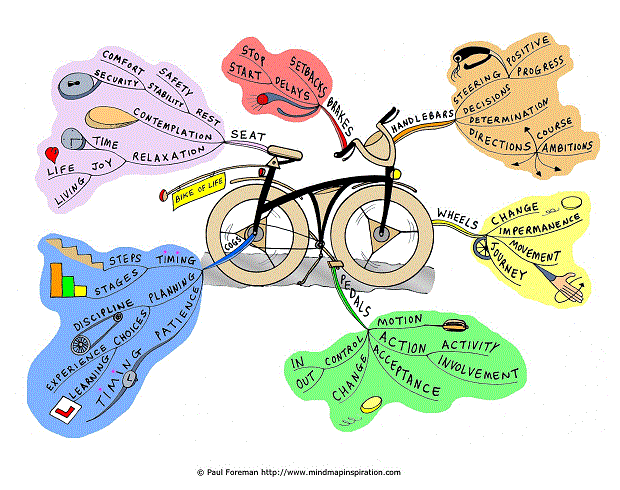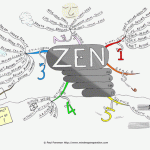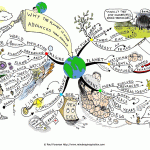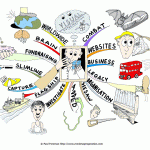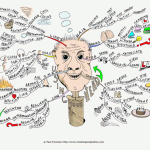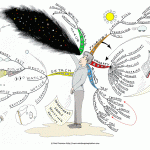Quick history
The bicycle is said to have been invented by British cycle-maker John Kemp Starley (1855-1901) who demonstrated his model in 1885. J.H. Lawson’s invention of the chain-drive powered the rear wheel. The Starley Rover Safety model featured spoked wheels of almost equal size, a diamond-type frame and adjustable seat and handlebars. Starley’s uncle James Starley developed the penny-farthing with a giant front wheel and tiny back one. John Starley’s bicycle was termed a safety bicycle due to a more sensible design, height and balance. It had no brakes yet was still safer than the tall penny-farthing. The bicycle was hugely popular and has evolved in many directions ever since. (Source of reference: 1001 inventions that changed the world ISBN 9781844036110)
Prior to Starley, in 1790 Comte de Sivrac of France invented a wooden bicycle.
The bicycle is simple, cheap and pollution free and ideal as transport and for exercise. The wheel dates back 5,500 years around 3500 B.C. as a potter’s wheel then 300 years later fitted to carts beginning the age of wheeled transportation. Wheels held together by wire spokes appeared in about 1800. Then, in the 1950’s metal wheels replaced wire wheels in cars.
Imagine for a moment the life-changing effect of providing bicycles to people in countries without them by recycling and building bikes from spare parts and all the wasted components on our rubbish tips. A bike can be the only form of transport for many – something so simple that we all take for granted because there are billions of them around the world.
That is a brief history and life of the bicycle, yet what of the reverse – the bike of life? Life moves, bicycles move and the two have quite a few interesting connections. How might parts of the bicycle represent parts of life?
Seat
Few things remain constant in life, it has ups and downs yet the seat might reflect a place of safety, of stability, the comfort and security of the known or given. It could also represent rest and relaxation, the moments we have for contemplation, time to think and time to explore the joy of life and living in our own unique way.
Brakes
The brakes might reflect times of slowing down or of setbacks and delays, the stops and starts of life. Change happens and no one escapes the cycles of impermanence; things come, things go. One minute coasting or free wheeling, the next minute grounded to a halt – possibly even catapulted over the handlebars. What they say about crashing a bicycle is good advice – get back on straight away or you may convince yourself not to try again. The brakes are not only an indication of outer circumstances, the brakes can also stand for your thinking – your thoughts can stop you far more easily than outer events. Negative thinking can ground you to a halt; positive thinking can free you to regain momentum. The power of brakes, the power of thought; the skill of mastering their application.
Handlebars
The bicycle would not get far without handlebars; without steering, without choice of direction. It takes steady skill and determination to maintain a course of positive progress. You can veer off course, wobble, stray off line, take wrong turnings and choose wrong directions yet ultimately you steer. The bicycle goes in the direction you point it and so does your life via your ambitions, aspirations and thoughts. Occasionally you find a straightforward route, other times steep hills – it cannot be all sprints either or you’ll burn yourself out; balance is key and so is knowing where you wish to be heading.
Wheels and pedals
The wheels of the bicycle represent movement, change and impermanence – the constant journey. Life moves whether you stay still or not; you can move with life and flow or against life and struggle, either way time elapses and the wheels keep turning. Your past is in the tracks your wheels leave behind, gone, and shifting constantly every second of every day. Your present is now as you ride the bicycle of your life in the moment and your future is ahead of you where your wheels have yet to travel. The wheels represent motion, constant change and the spokes reflect a multitude of individual ingredients, a unique blend of personal circumstances.
The pedals of your life drive the wheels of your life; the bicycle of life. The pedals create action and motion, activity and involvement. You can pedal slow, fast or coast. Sometimes you can pedal frantically and get nowhere other times, in the right gear at the right time you can fly. The pedals allow you some control in gauging the speed of your life; everyone travels at different speeds with different circumstances and expectations.
Cogs
The cogs and gears represent timing and skill, negotiating the steps and stages. Change up or down too fast and you can miss gears or even lose the chain completely. Technique, planning and discipline allow you to work through the cogs at the right pace, with the right timing by balancing choices, experiences, skills, learning and patience. Wrong gear and the bicycle of life is either hard work or all effort and no motion. Fine balance maintains forward momentum, minor adjustments and delicate finesse allow you to journey safely and efficiently.
Offshoots
What of the offshoots?
Custom bikes, racing bikes and mountain bikes, unicycles, tandems, the tour de France, the Olympics, tricycles, exercise bikes, an endless list of connections and associations and an infinite field of potential design and direction.
Summary
The bicycle of life is your design – you can add all manner of gadgets and accessories, even go faster stripes yet beneath the styling the practicality remains. The journey, the path, the past, the present and the future.
If you ride a bike you have a destination and a goal.
How might the bike of life apply to you?
Here are some probing questions for contemplation:
Am I working to enrich my life?
Am I working to enrich the lives of others?
Am I creating a legacy of meaning?
Am I making a difference?
When should I pedal or coast?
How am I travelling?
Where to?
What for?
Why?
Who is steering?
More from Mind Map Inspiration:
Submit your review | |

